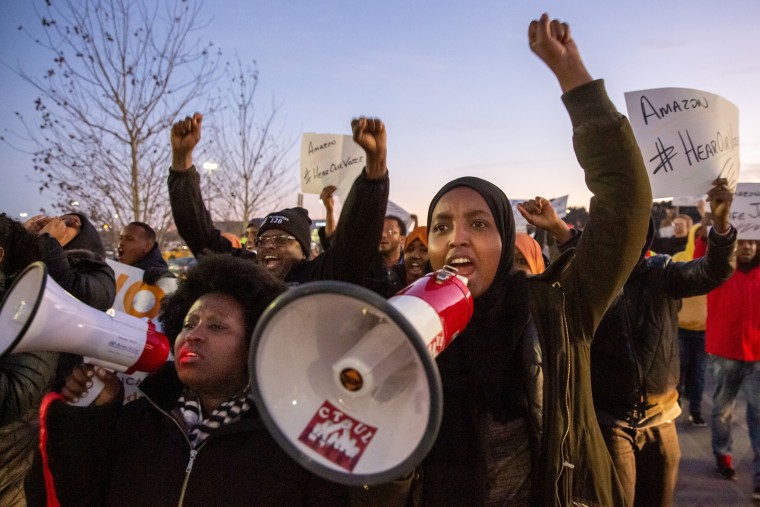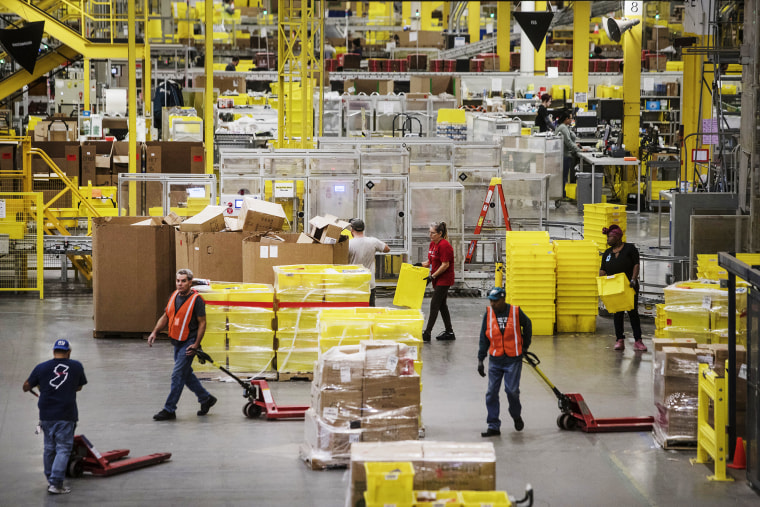Instead of cramming themselves into shopping centers on Black Friday, many Americans will opt for the relative ease of clicking through an endless selection of cheap deals on Amazon — no lines, ultra-fast shipping, instant gratification. But the e-commerce giant's convenience comes with hidden surcharges: The social cost of its retail dominance manifests in workers’ battered bodies, the mental exhaustion of brutal production quotas, a sprawling carbon footprint and lavish tax subsidies that come out of consumers’ pockets.
This week, Amazon workers want the company to pay for its ill-gotten gains and are demanding fair pay, the right to organize and an end to punishing work regimens that press employees to labor with the machinated discipline of the robots bustling alongside them. Amazon’s own records suggest that the pressure to process orders at a breakneck pace — long shifts packing hundreds of items per hour — creates major hazards. Workers have suffered strains and sprains while hauling boxes, gotten crushed by machinery or gotten struck in the head by a package, all incidents documented in injury records reported by Reveal.
At the JFK8 fulfillment center on Staten Island, the 2018 injury rate was a stunning 15.2 per 100 workers, triple the national average for the warehousing industry, according to data analyzed by Make the Road New York and New York Communities for Change. Each injured worker was forced to miss a total of about 64 days of work on average. During the peak shopping season between Thanksgiving and Christmas, 17 workers suffered injuries severe enough to force them off the job altogether.
In interviews with researchers with New York Committee for Occupational Safety and Health, Staten Island Amazon workers described the physical toll of their jobs: Eighteen percent reported suffering physical injury, and two-thirds reported suffering bodily pain while working. Although Amazon does provide some safety training and rest breaks, one worker noted that the high-speed workplace culture was at odds with the safety guidance: “when you’re working so fast, you’re not going to follow those mandates.”
Workers at an Amazon facility in Shakopee, Minnesota — mostly East African immigrants — have also complained of oppressive working conditions, with extreme productivity quotas, frequent physical injuries, crushing bouts of anxiety and, lately, retaliation by management against workers who have protested for improved working conditions.

With hundreds of thousands of employees, Amazon's disruptive impact extends beyond the warehouse. According to a study by California-based think tank Economic Roundtable, Amazon's trucking operations across the four-county Los Angeles region led to “$642 million in uncompensated public costs for noise, road wear, accidents and harmful emissions.”
While surrounding communities depend heavily on Amazon as a source of blue-collar jobs, researchers found that about 57 percent of workers lived in “overcrowded and substandard” housing, and most were supplementing their Amazon wages with thousands of dollars in public benefits, like food stamps.
Although Amazon has recently responded to public pressure to raise its wages, announcing a new minimum wage of $15 per hour in 2018 — a full-time yearly salary of $31,200 — that still falls well short of the living wage in the Los Angeles area. (The Economic Roundtable, for instance, recommends an hourly base wage of $20, along with comprehensive health benefits and on-site childcare.)
The study also reveals how the communities that depend on Amazon for jobs and retail services are exposed to the company’s environmental footprint. Overall, the company emits roughly 44.4 million metric tons of carbon annually, driven in large part by logistics and warehousing operations and technology ventures, like its massive data centers. In the Los Angeles region, Amazon’s vast logistics network — roughly 21,500 diesel truckloads of merchandise delivered by land, air, rail and sea to 21 warehouses each day — results in about 620,000 metric tons of carbon dioxide from cargo flights in 2018, which ultimately cost the public some $45 million in damage to “agricultural productivity, human health, flooding and ecosystem services.” That doesn’t even account for the extensive “last-mile” delivery operations — which often involves dispatching a subcontracted workforce of “flex” couriers who shuttle packages from warehouses to your doorstep, without basic labor protections or benefits.
Yet taxpayers end up paying for the privilege of hosting Amazon in their communities: Amazon netted nearly $58 million in state and local subsidies across the Los Angeles area, including subsidies for the production of Amazon movies from the California Film Commission and warehouse development subsidies from local authorities seeking to court investment.
While capitalizing on public subsidies, Amazon has also formed lucrative “partnerships” with government agencies, by providing cloud computer services to police as well as immigration enforcement and military operations.
Today, however, Amazon's seemingly unstoppable expansion is getting checked by its workers. While they are not yet unionized, JFK8 workers rallied this week for more humane working conditions; Shakopee workers are campaigning for a workplace health and safety committee; and they join dozens of other organizations in a new grassroots alliance, Athena, to demand workplace justice at Amazon nationwide. In addition, hundreds of corporate employees have demanded stronger measures to zero out carbon emissions, as well as a pledge not to partner with agencies and companies that threaten civil rights. Meanwhile, some lawmakers have been pushing to hold Amazon accountable for both its labor practices and its monopolistic power as an e-commerce hegemon.
Though these actions might not compel a trillion-dollar corporate giant to overhaul its business model, each act of resistance leverages people power against a phalanx of roboticized capitalism. This year, intense opposition from labor and community groups in New York thwarted Amazon’s plans to build a new corporate headquarters in Queens. That movement’s ethos of grassroots resistance is extended with every step that Amazon employees take to build democracy at work.
Amazon is gearing up for another quarter of eye-watering profits. But peer beyond the seamless efficiency of Amazon’s e-commerce empire, and you’ll see the workers on the inside warning us that rock-bottom prices and superfast shipping are costing all of us more than we know — and when we buy now, our communities pay later.



